Lifestyle at lake Titikaka
- CTR
- Nov 20, 2015
- 4 min read
Lake Titicaca is the highest navigated lake in the world at the altitude of 3 810 m above sea level. Peru shares it with Bolivia. The lake has a unique character, as the 100 small floating islands are manmade, constructed of lake earth and successive layers of reed. The lake is a rich biotope protected by Unesco as World Heritage (http://whc.unesco.org/en/tentativelists/5080/).
The local communities are based on nuclear families which inhabit every floating island. The islands are constructed by the family leaders with help from neighbors and friends. Their economy is based on fishing, hunting and trading with the tourists, who reach their islands via tour boats. They consume mainly their local products from the lake (fish, birds and reed parts) but they also exchange them at the nearby town Puno with potatoes and vegetables. With the money earned from the touristic trade, they buy modern technological products.
Striking is that on the islands they use solar energy –which is not a very common source of energy in Peru- in order to have electricity (radio, television etc.).
They still cook though in old traditional three-roomed clay stoves.
Fashion at the Uros islands
We have visited and talked with the people from one of the Uros floating islands. The members of the family living there has explained us how men construct the reed islands from the lake earth and the reeds and how their daily life is.
The people wear the local traditional costumes, mixed with some modern clothes. Their traditional textiles have very bright colors produced with industrial dyes. The modern embroideries have also bright colors on white but also on dark grounds.
The female costume at Titicaca has little in common with the Andean costumes of the Cusco area. Here women wear monochrome, long and wide pleated skirts in bright, almost fluorescent colors (fuchsia, yellow, light blue or green).
The skirts have sometimes three horizontally sawn pleats, perhaps in order to save some fabric and use it later when the girls would become taller.
Women wear white knitted blouses and colored vests with colorful edges. When they have to add modern clothes to their wardrobe i.e. from synthetic fleece, they choose the same bright colors combined with their old traditional clothes. Women wear straw or dark felted hats. Young girls fix long colorful tassels on the back of their hats, which are replaced by similar ones but in another color when they get married.
Men wear a white shirt over that a local traditional woven vest with stripes. Their trousers are sometimes replaced by modern black sporty trousers. Interesting is that they wear sometimes modern cotton hats, which protect them well from the sun but they wear a traditional cup over them in order to keep the local dress character for the tourists.
Dress code on the Taquille island
On one of the natural islands of the lake, Taquile, there is a weavers association and a market room, where the locals sell their textile products. These are woven and knitted clothes and accessories made of fine cotton or wool with colorful bands and tiny patterns. They share the general clothing trends with the people from the floating islands but here they appear to be more strict with the dress code, the rules and the rituals.
Women wear wide pleated skirts in bright colors, a white shirt and they carry a black square textile piece, which is for carrying goods up at the long steep road from the harbor of the island up to their houses on the slopes and the central square on the top of the island. They wear various white underskirts with colored edges, which seem to be influenced from the old Spanish costumes.
Men wear black trousers, a white shirt with woven decoration and a sleeveless vest with woven bands. Very characteristic is the mens’ belt, which is a wide woven band with patterns referring to the history of their family. They never lent or sell this very personal item, unless it is a replica - because it has a great symbolic value for them.
Men’s head cover is a knitted cap with a very long tale and a tassel. The caps of young boys are white and the cap of married men dark. On the Taquile island only men knit. They make caps, gloves, shawls and belts with 4 fine metal needles.
Women only weave on their loom indoors and they are not keen to show their private rooms to visitors. Some photographs in the exhibition room show though, that women in Taquille used a wooden framed loom.
Recycling at Titicaca
Footwear in Taquille likewise in all other Titicaca islands is a kind of black open sandals made of old rubber tiles. The shoes of women are sometimes decorated with colorful strasses. These are not made on the islands but they are bought in the markets of Puno.
Old shoes are often used as an elastic joining material for other purposes such
as door hinges. Rubber stripes can be also repurposed as connecting material for various light constructions such as huts and market tables.
Our visit at the Titicaca lake has shown us that except from clothing items the local people have developed original textile and basketry techniques in order to construct many different artifacts, such as pieces of art, tools, furniture, houses, boats, even their living space, the floating islands, from their only local natural material, the reeds of the lake.
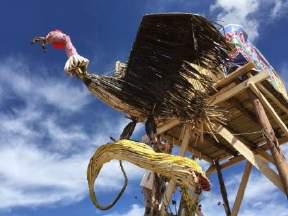




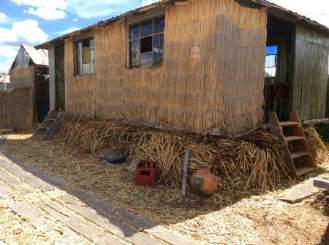
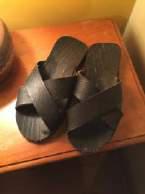


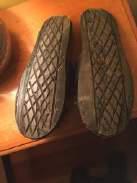
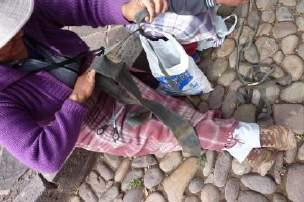
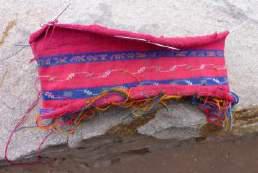
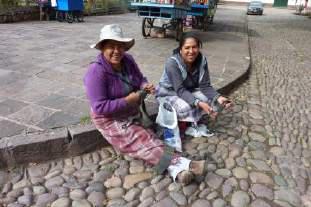

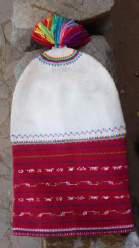


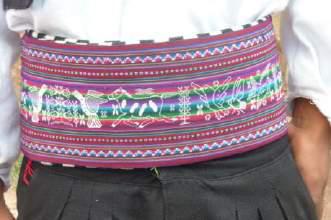

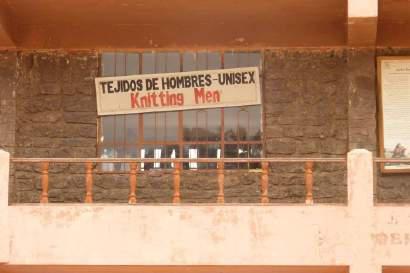



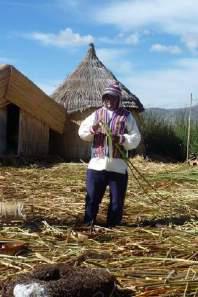




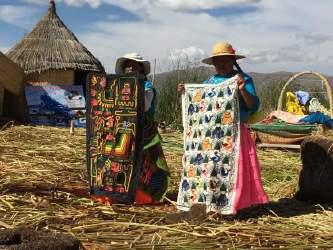









Comments